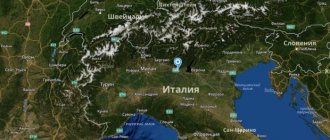Mary Magdalene: who is she?
Mary was from the small town of Magdala, located near Capernaum in Galilee (the modern village of Medjdel). She lived in the 1st century. The Gospel does not contain the life of Mary Magdalene and the story of her meeting with Jesus Christ. However, it is indicated that she received healing from evil spirits and diseases.
The Holy Fathers of the Church believe that Mary Magdalene was not married. This was impossible due to infirmities (obsession or illness). Evidence can be found in the fact that the evangelists added the husband's name to the names of women to distinguish them. Maria is named after her place of origin.
Equal to the Apostles Mary Magdalene (Orthodox icon)
What is there to argue about?
There are several episodes in the Gospel that can be associated both with Mary Magdalene and with other women known to Christ. And this creates space for different assumptions and discussions.
Mariotto di Nardo. Meeting of Mary Magdalene with the risen Christ (fragment) XIII century
Episode 1: First meeting with the risen Christ. Many authoritative church writers - George of Nicomedia, Gregory Palamas and some others - expressed the opinion that the first who was honored to see the risen Lord was His Most Pure Mother. And some believed that it was about Her, and not about Mary Magdalene, that the Apostle John tells in the episode with the tomb and Jesus the “gardener.” The latest version was put forward, in particular, by the Monk Ephraim the Syrian, who lived in the 4th century and read all four Gospels in a combined form, written by the Syrian Christian writer (who later deviated into heresy) Tatian. But most of the holy fathers still relied on the testimony of the Apostle John that the Lord appeared to Mary Magdalene. They considered this phenomenon a kind of “reward” for her faith, fearlessness and selfless love for the Savior.
For example, St. Cyril of Alexandria (376–444) drew attention to the fact that even before the death of the Savior, Mary Magdalene continued to fearlessly call Him Lord, for which she was honored with a miraculous appearance of Angels, and then a personal meeting with Christ.
Christ in the house of Simon the Pharisee. 17th century
Episode 2. A woman sinner pours precious ointment on Christ. It has been repeatedly suggested (especially in the Western Church) that this woman was Mary Magdalene.
We are talking about an episode described by the Evangelist Luke:
One of the Pharisees asked Him to eat food with him; and He entered the house of the Pharisee and lay down. And so, a woman of that city, who was a sinner, having learned that He was reclining in the house of a Pharisee, brought an alabaster flask of ointment and, standing behind His feet and weeping, began to wet His feet with tears and wipe them with the hair of her head, and kissed His feet. , and smeared it with myrrh. Seeing this, the Pharisee who invited Him said to himself: if He were a prophet, He would know who and what kind of woman was touching Him, for she was a sinner. In response to this, Christ shamed the owner of the house and said: ... Her many sins are forgiven because she loved much, but he who is forgiven little loves little (Luke 7:36–39, 47).
Byzantine interpreters, as a rule, shared the images of the sinner who anointed Christ’s feet with myrrh and Mary Magdalene. The majority of modern biblical scholars are also against their identification, if only because the Evangelist Luke first mentions Mary only in the 8th chapter (following the story of the anointing with chrism), and as a character who is introduced into the story for the first time.
In addition, the same (most likely) episode with pouring out fragrant myrrh on Christ is described by the Evangelist Matthew, although with some changes (Matthew 26 :6-13). And he clarifies that the matter took place in Bethany, that is, several kilometers from Jerusalem, a few days before the Crucifixion of the Lord Jesus Christ. But then it is absolutely incredible that Mary Magdalene, the Savior’s longtime companion, who joined the apostolic community back in Galilee (located relatively far from Jerusalem) and, of course, long ago healed of demons by the Lord, would be called a “sinner.”
Caravaggio. Martha and Mary Magdalene. 1598 Mary Magdalene - right
Episode 3. More precisely, even a series of episodes related to Mary, Lazarus' sister. In the Gospel of John there is another version of the story about the anointing of the Lord with precious myrrh, and this is done, according to the fourth evangelist, by one of the sisters of Lazarus resurrected by Christ, Mary (John 12 :1-8). In the Roman Church there was an opinion that this The evangelists called Mary Magdalene. This guess was expressed, in particular, by Pope Gregory the Great († 604) (at that time the Catholic Church had not yet broken away from the Orthodox Church, and the Roman popes did not consider themselves “vicars of Christ on earth,” but were simply bishops of Rome): he believed that the sinner woman who poured fragrant incense on the Lord, Lazarus’s sister Mary and Mary Magdalene are one and the same person. This version was also supported by some other Western interpreters and theologians, for example the British monk Bede the Venerable (†735).
But even earlier, in the 3rd century, Saint Hippolytus of Rome tried to “replace” Mary Magdalene with the sisters of Lazarus (and both at once - Martha and Mary). It is Martha and Mary, and not Mary Magdalene, who turn out to be the main witnesses of the Resurrection of the Savior in the surviving fragments of his commentary on the Song of Songs!
However, it is extremely unlikely that Mary Magdalene was actually Lazarus' sister. All evangelists call Magdalene a Galilean (let us remember once again that Magdala is a Galilean city), while Lazarus and his sisters lived in the Jerusalem suburb of Bethany. And many authoritative monuments of the ancient Church (for example, the “Apostolic Constitutions,” dating from the end of the 4th century) describe Mary Magdalene and Lazarus’ sister Mary as completely different people.
David Teniers Jr. A woman caught in adultery. 1626–1690
Episode 4. Christ delivers a woman taken in adultery from stoning. The story of this is contained only in the Gospel of John (John 8 :3-11), and mainly in later manuscripts. It is often believed that this is a later insertion, only attributed to the authorship of the Holy Apostle John. Be that as it may, this episode does not give any reason to believe that the woman whom the scribes and Pharisees brought to the Lord Jesus and wanted to stone was Mary Magdalene. This version is still sometimes heard, but it appeared only in the Middle Ages in Catholic sources, and there are strong arguments against it. First of all, the one about which we have already said: the meeting of Christ with Mary Magdalene almost certainly took place in Galilee shortly after He went out to preach, and the episode with the sinner takes place in Jerusalem, and Christ is already well known to the Jews.
Equal to the Apostles Mary Magdalene: Gospel narrative
Having left everything and becoming a disciple of the Savior, Mary Magdalene accompanied Him everywhere. She served Him along with other holy women. She also stood near the Cross on which Christ was crucified. Mary Magdalene was among the myrrh-bearing women who, having prepared aromatic oils to anoint the body of the deceased Jesus Christ, came to the tomb.
Seeing the stone removed from the entrance to the tomb, Mary Magdalene hastened to inform the apostles Peter and John the Theologian about this. Arriving at the tomb for the second time after the apostles, she personally entered the tomb. There Mary Magdalene saw angels who told her that Christ had risen. Then she was destined to be one of the first to see the resurrected Jesus. But when she saw Him, she did not recognize Him immediately, but only after addressing her by name. After this, Mary Magdalene ran to tell the apostles the news of the Resurrection of Christ.
Thus, Mary Magdalene became the first witness and evangelist of the Resurrection of Christ.
As St. Gregory the Theologian (c. 325 - 389) noted: “The woman received the first lie from the mouth of the serpent, and the woman from the mouth of the Risen Lord Himself was the first to hear the joyful truth, so that whose hand dissolved the drink of death, the same one would give the cup of life.” (St. Demetrius of Rostov, Biography of the Holy Myrrh-Bearing Equal-to-the-Apostles Mary Magdalene, Chetya-Minea, July 22).
And as the theologian Bede the Venerable (7th-8th century) said: “Now she who tasted death first sees the Resurrection first, so that she will not be forever guilty of sin before men. The wife who brought wine to her husband has now brought him grace.” (Interpretation of the Gospel of Mark)
Modern interpretations
Mary Magdalene continues to be an object of fascination for both religious devotees and secular media. In Martin Scorsese's film adaptation of Nikos Kazantzakis' novel The Last Temptation of Christ, Andrew Lloyd Webber's musical Jesus Christ Superstar and Mel Gibson's The Passion of the Christ depicts Mary as a repentant sinner. However, in Dan Brown's popular novel The Da Vinci Code, Mary is portrayed as she is in the Gnostic gospels.
Mary's story came into the spotlight again during NBC's live broadcast of Jesus Christ Superstar on Easter Sunday 2018, with Sara Bareilles inhabiting the role. Around the same time, Mary Magdalene hit theaters with Rooney Mara as a younger version of the titular character seeking to escape an arranged marriage and Joaquin Phoenix as Jesus Christ. The story came into the spotlight again during NBC's live broadcast of Jesus Christ Superstar on Easter Sunday 2021, with Sara Bareilles inhabiting the role. Around the same time, Mary Magdalene hit theaters with Rooney Mara as a younger version of the titular character seeking to escape an arranged marriage and Joaquin Phoenix as Jesus Christ. The story came into the spotlight again during NBC's live broadcast of Jesus Christ Superstar on Easter Sunday 2021, with Sara Bareilles inhabiting the role. Around the same time, Mary Magdalene hit theaters with Rooney Mara as a younger version of the titular character seeking to escape an arranged marriage and Joaquin Phoenix as Jesus Christ.
Mary Magdalene: harlot?
There is no indication in any Gospel that Mary Magdalene was a harlot. This assumption was put forward by Pope Gregory the Great (540-604). He compared her with the woman whom Christ saved from being stoned.
However, in contrast to this, Saint Demetrius of Rostov (1651-1709) gives the following argument. If Mary Magdalene really was a harlot, then the Pharisees and scribes who constantly accompanied Jesus would have exploited this. They would certainly reproach the Savior for the one who is constantly with Him.
Notes
- Encyclopedia of Ukrainian Studies.// Mazepa Marina (in Chernetsk, Mary Magdalene)./// Photo. - Lviv:NTSh, 1994. - T. 4. - Store. 1433
- [www.nbuv.gov.ua/portal/Soc_Gum/Gileya/2009_25/Gileya25/I1_doc.pdf Krivosheya V.V. Stepan Mazepa and Bilotserkivshchina // Collection of scientific works of Gileya (scientific newsletter) No. 25 (2009)]
- [litopys.org.ua/coss3/ohl06.htm Oleksandr OGLOBLIN. HETMAN IVAN MAZEPA TA YOGO DOBA. Another additional sight. 2001]
- Tairova-Yakovleva T. G. Mazepa. - M.: Young Guard, 2007. - 271 p.: ill. — (Life of remarkable people: Ser. biogr.; issue 1041).
- ↑ 12
[www.ukrajinci.hu/arhiv/hromada_93/ukrajinky/mazepena.html Zoya Khizhnyak. Hetman's mother Maria Magdalena Mazepina. // Community No. 1(92) January-February 2008] - ↑ 12
[www.siver-litopis.cn.ua/arh/2007/2007n5/2007n05r04.pdf Serhiy PAVLENKO. RODOVID OF HETMAN I. MAZEPI. // Siveryansky lithopis, No. 5 2007] - Kilesso T. S. Vidubitsky Monastery. Kiev; “Technology”, 1999. -S.-130.
- The most beautiful story in the history of Ukrainian harpment is the work of Maria Magdalena Mazepina, the mother of Hetman Ivan Mazepa.
-[old.risu.org.ua/ukr/resourses/library/lis/1996/11-12_9-12/ Tetyana KARA-VASILYEVA. Ukrainian liturgical sewing. // People and the world. - 1996. - No. 11-12. — P. 9-12] - ↑ 12
[old.risu.org.ua/ukr/resourses/library/lis/1996/11-12_9-12/ Tetyana KARA-VASILYEVA. Ukrainian liturgical sewing. // People and the world. - 1996. - No. 11-12. — P. 9-12] - Pavlenko S.
Ivan Mazepa as an everyday person of Ukrainian culture. VD "Kyiv-Mohyla Academy", 2005, p. 144.
Saint Mary Magdalene: veneration in Orthodoxy
The Orthodox Church venerates Mary Magdalene as one of the myrrh-bearing women. The Catholic Church in the person of Mary Magdalene unites the personalities of three wives. First, the person of the sinner (harlot) who came to the house of the Pharisee Simon, who washed Jesus’ feet with her tears, wiped them with her hair and anointed them with fragrant oil.
Secondly, the personality of Mary, the sister of Lazarus, whom Christ resurrected on the fourth day after death. Thirdly, the immediate personality of Mary Magdalene, from whom the Savior cast out seven demons. In Orthodoxy, these holy women are venerated separately.
Life of Mary Magdalene after the Resurrection of Christ
As the life of Mary Magdalene says, after the Resurrection of Christ she remained in Jerusalem for some time. And then, like the apostles, she went to preach faith in the true God to other people. She arrived in Rome and testified about the Resurrection of Christ before Emperor Tiberius himself (14-37 years old). Mary Magdalene presented him with a gift in the form of a white egg, according to ancient Jewish custom. The egg in the emperor's hands changed color and became red. After this, a tradition arose in the Christian world of giving colored eggs for Easter. Tiberius, according to this legend, believed that Jesus was the Son of God and even wanted to include Him in the Roman pantheon.
Also, the life of Mary Magdalene tells that she preached not only in Italy, but also in Gaul (France), Egypt, and Syria. Then Mary Magdalene preached the Gospel in Ephesus (Asia Minor) together with the Apostle John the Theologian. Here she ended her earthly life.
During the reign of Emperor Leo VI the Philosopher (9th century), her incorruptible relics were transferred to Constantinople (modern Istanbul, Turkey). Then, during one of the crusades, they were transported to Rome (Italy). Now particles of the relics are found in many countries around the world.
Saint Mary Magdalene is numbered among the women equal to the apostles, who, along with the apostles, worked in spreading the Christian faith.
The days of remembrance of Saint Mary Magdalene, Equal to the Apostles, were established by the Orthodox Church on August 4 according to the new style and on the second Sunday after Easter.
Astronomers believe that several supernovae explode in the Milky Way every hundred years. During the planet's existence, some of them would have exploded very close to it, possibly with catastrophic consequences. What impact did this have on life on Earth in general and on human evolution in particular?
For our Australopithecus ancestors, who roamed Africa 2.5 million years ago, a bright new star in the sky would certainly have aroused curiosity. As bright as the full moon, it would cast shadows at night and be visible during the day. As the supernova faded over the following months, it likely faded from memory. But she left other traces that are being discovered today.
Over the past two decades, researchers have discovered hundreds of radioactive atoms “buried” in mineral deposits on the seafloor that were created by an ancient explosion that marked the death of a nearby star. After burning nuclear fuel, the star collapsed, the core collapsed, and the resulting shock wave threw its outer layers to the sides, forming an expanding ball of gas and dust, the temperature of which was so high that for an instant the dying star flared up brightly, like a galaxy. As a result, these atoms rained down on the Earth, which are eloquent evidence of what happened.
Flashes of X-rays and gamma rays, erupting from hundreds of light years away, probably did not harm the Earth. But the expanding fireball accelerated the cosmic rays—mostly hydrogen and helium nuclei—to speeds close to the speed of light. These “shells” would arrive unnoticed, decades later, in an invisible barrage, like a barrage, that could last thousands of years and could affect the atmosphere—and life.
Through much research and speculation, astronomers have outlined their possible consequences. It is quite possible that under the influence of a barrage of cosmic rays, the frequency of mutations increased due to the destruction of the Earth's protective ozone layer and the creation of streams of secondary particles that penetrate into tissues. Apparently, having broken through the atmosphere, these particles also created channels for the passage of lightning, which may have caused an outbreak of forest fires. At the same time, atmospheric reactions caused by radiation could cause a rain of nitrogen compounds that served as fertilizer for plants that absorb carbon dioxide. Thus, this astronomical event may have caused a cooling of the climate and contributed to the onset of the ice age 2.5 million years ago, at the beginning of the Pleistocene era. These effects, even taken together, "are not like the extinction event of the dinosaurs—it's not as noticeable and localized," says astronomer Brian Thomas of Washburn University, who has been studying the effects of cosmic disasters on Earth for nearly 20 years.
Few astronomers suggest that supernovae caused any significant extinction events at that time, and even fewer paleontologists are willing to believe them. “Death coming from space always looks really cool,” says paleontologist Pincelli Hull of Yale University. “The factual material is interesting, but it hasn’t quite reached the level needed to wrap my head around it.”
However, scientists who search for supernovae believe that other explosions, more distant in time, occurred closer to Earth. And they think these supernovae may be responsible for some extinction events that lack the usual triggers like volcanic eruptions or asteroid impacts. Adrian Melott, an astronomer at the University of Kansas at Lawrence who studies how cosmic cataclysms near Earth may not have affected it, says it's time to start looking more closely at Earth's history for ancient supernovae. This will not only help astrophysicists understand how explosions formed the planets in our solar system's neighborhood and seeded it with heavy elements, but it could also give paleontologists new insights into recurring global changes. “It’s something new and unfamiliar,” Melott says. “It takes time to accept it, to believe it.”
Astronomers believe that several supernovae explode in the Milky Way every hundred years. According to the law of averages, during the Earth's 4.5 billion years of existence, some of them should have exploded very close to the Earth - within 30 light years - and possibly with catastrophic consequences. Even explosions occurring up to 300 light years away should leave traces of dust grains ejected with a shell of debris known as supernova remnants. When physicist Luis Alvarez and his geologist son Walter Alvarez set out in the 1970s to study the upper layers of sediment associated with the extinction of the dinosaurs 65 million years ago, they expected to find supernova dust there. Instead, they discovered iridium, an element that is rare on Earth's surface but abundant on asteroids.
In any case, the Alvarezes did not have the tools to search for supernova dust. Since the Earth is already largely composed of elements created in supernovae billions of years ago, before the sun, most traces of later explosions cannot be detected. But some can be found. In the 1990s, astrophysicists realized that supernova dust could also precipitate radioactive isotopes with half-lives of millions of years, too short to have existed since the Earth began. Those that are found must be the result of dispersal from recent (from a geological point of view) explosions. One key indicator is iron-60, an isotope of iron formed in the cores of large stars that has a half-life of 2.6 million years and is not produced naturally on Earth.
In the late 1990s, physicist Gunther Korschinek at the Technical University of Munich (TUM), who studies astroparticles, decided to look for it, partly because the university had a high-power accelerator mass spectrometer (AMS) suitable for this purpose. After the sample is ionized, the mass spectrometer accelerates charged particles to high energies and passes them through a magnetic field. Under the influence of the magnetic field, the direction of their movement changes, and they rush towards the detectors. The direction of motion of the heaviest atoms changes the least because they have greater inertia.
It is particularly difficult to separate iron-60 atoms from the equally massive but differently charged nickel-60 atoms, but a mass spectrometer at the University of Munich, built in 1970, was one of the few in the world that was powerful enough to separate them. from friend.
In addition, Korshinek needed the “right” sample - a fragment of geological sediment formed over millions of years in which traces of iron could be identified. Cores taken from the ice of Antarctica were not suitable for this, since their age is only about a couple of million years. Most ocean sediments accumulate so quickly that any traces of iron-60 are dissolved to undetectable levels. Korshinek eventually used a fragment of surface ferromanganese sediment recovered from a seamount in the North Pacific Ocean by the German research vessel Valdivia in 1976. This surface layer forms in areas of the seafloor where sediments cannot settle due to slope or currents. At suitable water pH, metal atoms selectively precipitate out of the water at a rate of a few millimeters per million years, slowly forming a mineral crust.
Korshinek and his colleagues cut their sample into layers of different ages, chemically isolated the iron, and ran the atoms through their mass spectrometer. In 1999, in the scientific journal Physical Review Letters, published by the American Society of Physicists, scientists wrote that among thousands of trillions of ordinary iron atoms they had discovered 23 iron-60 atoms dating back to less than three million years ago. The era of supernova geochemistry has begun. “We were the first to do experimental research,” says Korzynek.
Others followed. Iron-60 has been found in the surface layers of ocean sediments taken from other parts of the world and even in microfossils of ocean sediments, microscopic fossil remains of living creatures that, to the delight of supernova hunters, “absorbed” and accumulated iron in their bodies. Most of the results pointed to a local supernova explosion between two and three million years ago - with some traces pointing to a second supernova explosion several million years earlier.
Although the remnants of these explosions have long passed by the Earth, the rain of atoms thrown out by them continues. In 2021, Korshinek's team obtained iron by running half a ton of fresh Antarctic snow through its mass spectrometer and discovered several iron-60 atoms that he estimates fell to Earth over the past 20 years. Another team of scientists found a small number of atoms in cosmic rays detected by NASA's Advanced Explorer spacecraft, launched to study the composition of celestial bodies halfway between the Sun and Earth. Researchers have even discovered iron-60 in lunar soil brought back by participants in the Apollo missions. "The moon confirmed that this was not just some Earth phenomenon," says astronomer Adrienne Ertel of the University of Illinois at Urbana-Champaign (UIUC). Astronomer Dieter Breitschwerdt from the Technical University of Berlin is trying to trace the path of iron to its source in the sky. When he became aware of the results of Korshinek's research, he was studying the local "bubble", an area of space around the solar system that has been "cleared" of most gas and dust. The likely "broomsticks" were supernovae, so he began tracking groups of stars in the neighborhood of the solar system to see if they passed close enough to the Sun to "throw" iron-60 onto Earth when some of those stars exploded.
Using data from the European Space Agency's Hipparcos satellite, Breitschwerdt looked for clusters of stars on common trajectories and tried to turn back time to see where they were millions of years ago. It seemed that about 2.5 million years ago, in an ideal location - at a distance of 300 light years from Earth - there were two clusters that are now part of the Scorpius-Centauri OB association (Sco OB2). “It was like a miracle,” he says. The likelihood that the explosion occurred at the “right” time was high. Supernova core collapse occurs in high-mass stars. Based on the ages and masses of the 79 stars remaining in the clusters, Breitschwerdt suggests that a dozen former stars in the clusters have exploded as supernovae over the past 13 million years.
There is no visible evidence of these supernovae in Sco OB2 for a long time: after about 30 thousand years, supernova remnants dissipate, and the black holes or neutron stars they leave behind are difficult to detect. But the direction in which iron dust hit Earth could theoretically indicate its source. Samples from the seafloor do not provide any directional information because the dust is moved by wind and ocean currents as it settles. But the moon "has no atmosphere, so it stays where it is," says Brian Fields, an astronomer at the University of Illinois at Urbana-Champaign. Since the Moon rotates, the longitudinal direction is not suitable, but if more iron-60 was found at one of the poles than, for example, at the equator, this could serve as confirmation of Breitschwerdt's hypothesis that the source is Sco OB2. Fields and several of his colleagues want to test this idea, and they have asked NASA to provide them with samples of lunar soil that will be collected and returned to Earth during future lunar rover launches or manned missions to the Moon.
Korshinek's team now has competition in the search for supernova iron , a group of scientists led by Anton Wallner, a post-doctoral fellow on Korshinek's team. He is analyzing several surface layers of ferromanganese deposits recovered from the Pacific Ocean floor by a Japanese mining company at the Australian National University (ANU) using an upgraded accelerator mass spectrometer. “Now we have pushed Munich aside,” says Wallner.
This year, Wallner's team studied the timing of recent supernovae with greater precision than ever before, cutting a sample of surface sediment into 24 one-millimeter-thick layers, each representing 400,000 years, in a paper published in the American scientific journal Science Advances. “This has never been done before with such time resolution,” says Wallner, who works at the Helmholtz Center Dresden-Rossendorf. The 435 iron-60 atoms they recovered linked them to the most recent supernova explosion, 2.5 million years ago, and confirmed evidence pointing to another supernova that occurred earlier, which they calculated was 6.3 million years ago. By comparing the concentration of iron-60 in the surface layer of sediment with models indicating the amount of iron-60 produced in a supernova, scientists calculated the approximate distance from these supernovae to Earth - 160-320 light years.
In addition, Wallner's team discovered 181 atoms of plutonium-244, another radioactive isotope that may have been produced not by the explosion of a progenitor star (like iron-60), but by the supernova itself. True, there is fierce debate about the source of plutonium-244: some researchers believe that in supernovae the process of formation of plutonium-244 in large quantities is complex. They believe it is the result of collisions between neutron stars, and is supposedly ash left behind by supernovas.
These collisions, called kilonovae, occur 100 times less often than supernovae, but they produce much larger quantities of the heaviest elements. “When neutron stars merge, plutonium is formed easily,” says Rebecca Surman, an astrophysicist at the University of Notre Dame. “But in supernovae it’s much more complicated.”
But Surman still believes that the role of supernovae is great. She believes that the plutonium-244 found on the seabed is a sign that kilonova "filled" our interstellar space with heavy elements in the distant past. She suggests that when the last two supernovae exploded, their expanding remnants may have captured some of this interstellar plutonium-244 and brought it, along with their own iron-60, to Earth. However, Korzynek said more data about the plutonium wave and its timing would be needed to convince him that several rare events occurred so close and so recently.
What impact could nearby supernovae have had, other than showering the Earth with nuclei of rare elements? In 2021, a team of scientists led by Melott and Thomas estimated the flux of various forms of light and cosmic rays that would likely reach Earth in an explosion 300 light-years away. In a paper published in the American scientific journal Astrophysical Journal Letters, they concluded that the most active, potentially destructive photons - X-rays or gamma rays - would have minimal impact. “This creates so much high-energy radiation,” Thomas says. They suggested that a few weeks of bright light would have no more impact than disrupting sleep patterns.
Cosmic rays, particles accelerated to near the speed of light by shock waves in the expanding fireball of a supernova, are a different matter. Because they are charged, they can be deflected away from Earth by galactic magnetic fields. But the local “bubble” is thought to be largely field-free, so cosmic rays just 300 light-years away would encounter few obstacles in their path.
Melott and Thomas found that the atmosphere would have been subjected to a prolonged bombardment. “Reactivation is a slow process, lasting at least several decades,” says Thomas, explaining that the peak is reached about 500 years after the supernova, and there is a 10-fold increase in the ionization of atmospheric gas that will persist for five thousand years . Using a chemical model of the atmosphere developed by NASA, they estimated that chemical changes caused by ionization would deplete the ozone layer in some places by about 7% or more and accelerate the formation of nitrogen oxide compounds, which serve as fertilizer, by 30%. Perhaps the resulting dramatic increase in plant numbers was enough to cause the climate to become colder, creating the conditions for the start of the Pleistocene.
And cosmic rays have not disappeared anywhere. When high-energy particles enter the upper atmosphere, they create cascades of secondary particles. Most of them disappear in further collisions, but muons - the heavy, rapidly decaying relatives of electrons - continue to exist. Creatures on the surface of the Earth would receive three times the normal dose of radiation—equivalent to one or two CT scans per year. “It's an increased risk [of cancer], but not radiation damage,” Thomas says. Overall, these scientists said, the effects were "not catastrophic" but could be detected in the fossil record if, for example, some vulnerable species went extinct while others survived.
In a paper published in the scientific journal Astrobiology in 2019, Melott and two colleagues concluded that if a supernova exploded not 300 light-years away, but only 150 light-years away, the muon emission would be surprisingly severe. shock for marine animals. Water blocks most particles that fall from the sky, but muons can penetrate up to one kilometer deep. Marine creatures, normally protected from almost all types of radiation, would be subject to the greatest relative increase in dose and would suffer the most. This is comparable to the extinction of marine megafauna at the beginning of the Pleistocene era, only recently revealed in the fossil record.
Then, last year, proponents of the supernova hypothesis suggested that a similar scenario could have caused a major extinction event 359 million years ago, at the end of the Devonian period. A team of scientists led by John Marshall from the University of Southampton discovered that the spores of fern-like plants from that time suddenly became deformed and darkened, attributing this to exposure to ultraviolet radiation. However, scientists did not name an astronomical reason. But in an article published in the journal Proceedings of the National Academy of Sciences, astronomers saw this as a possible result of a nearby supernova explosion. They suggested that the explosion, perhaps just 60 light-years away, could have flooded the Earth with ultraviolet radiation, destroying the ozone layer. “This is purely hypothetical,” admits one of the paper's authors, John Ellis, a theoretical scientist at King's College London, since it is currently impossible to identify radioactive traces of a supernova explosion that long ago.
In a paper published in The Journal of Geology in 2020, Melott and Thomas looked even further back in time with their hypotheses. They noted that secondary cosmic rays, stripping electrons from air molecules, could create channels for lightning, increasing the likelihood of thunderstorms, which not only produced more nitrogen compounds, but also started forest fires. Interestingly, at the beginning of the Pleistocene, in some parts of the world, a layer of soot was discovered on rock paintings. Melott and Thomas theorized that these forest fires, caused by a supernova explosion, may have forced early humans out of the trees and into the savannah, leading to upright walking, increased brain size, and everything that followed. “It’s interesting to think that 2.5 million years ago a supernova had such an impact [on evolution] that we’re now talking on Skype,” says Korzynek.
Paleontologists don't really like such scenarios. “Timing is the trivial answer to everything,” Hull says. “Whenever something goes extinct, something happens.” Moreover, she said, the transition to the Pleistocene “needs no explanation.” She says other events occurring around the same time may have had a greater impact on global climate, such as the closure of the Isthmus of Panama, which severely altered ocean circulation.
To prove their case, she says, astronomers need to more accurately determine the timing of ancient supernovae. They "need to study more samples of the surface layer of sediment." But finding traces of supernovae is not getting any easier. In 2021, the Technical University of Munich closed down work on its accelerator mass spectrometer, and now only the Australian National University has an accelerator powerful enough to separate iron-60.
Rare isotopes such as plutonium-244 could allow researchers to look even further into the past, but they require mass spectrometers with accelerators that rely on sensitivity rather than just power. According to Wallner, there are very few mass spectrometers in the world that meet these requirements. He secured funding for the construction of a new scientific laboratory in the German city of Dresden, equipped with a mass spectrometer with an accelerator specializing in the study of the heaviest elements, it should be opened by 2023. To restart the search for iron-60, his research team also applied for government funding to build a new high-power accelerator mass spectrometer that could be operational in seven years.
For astronomers, a sudden flash of light in the sky today would be the best opportunity to see how a supernova affects Earth. But the chances of us seeing a light show like the one that may have blinded our distant ancestors are slim. Betelgeuse, a turbulent red giant star likely to explode sometime in the next 100,000 years, has calmed down in recent months and is in any case more than 500 light-years away. Sco OB2 is now moving away from the Sun. And using data from the European Space Agency's Gaia space telescope, the successor to Hipparcos, Dieter Breitschwerdt tracked 10 more star clusters. “None of them are coming close to us,” he says. “It’s the Earth’s bright future, not supernovas.”
Miracles through the prayers of Equal-to-the-Apostles Mary Magdalene
In the Athos Monastery of Simonopetra, one of the main shrines is the left hand of Mary Magdalene. These incorruptible relics have the temperature of a human body.
In 1911, on the island of Chalkidiki (Greece) there was an invasion of caterpillars that caused great damage to agricultural crops. After the ark with the relics was specially brought there and a prayer service was served, the invasion of caterpillars stopped. In 1912, locusts began to cause great harm to agriculture in the area of Thessaloniki (Greece). The pests disappeared only after the local residents served a prayer service to St. Magdalene.
In 1945 and 1947, through prayers to Equal-to-the-Apostles Mary Magdalene, the forest fire that raged near the Simonopetra monastery subsided.
Prayer to Saint Mary Magdalene
Oh, holy myrrh-bearer, equal to the apostles Mary Magdalene! With your warm love for Christ God, you trampled underfoot the evil machinations of the enemy and found the priceless pearl, Christ, and reached the Kingdom of Heaven. For this reason, I fall to you and with a tender soul and a contrite heart I cry out to you, unworthy one: look down from the heights of Heaven on me, who have been overcome by sinful temptations, see that the enemy besieges me with many sins and troubles every day, seeking my destruction. Glorious and all-praised disciple of Christ Mary! Pray to Christ God, beloved by you and who loved you, to grant me forgiveness of many of my sins, strengthen me with His grace to soberly and cheerfully walk the path of His holy commandments, and may He make me a fragrant temple of the Holy Spirit, so that in the world I will shamelessly end my difficult life on earth and I will dwell in the bright and blessed abodes of Heavenly Paradise, where you and all the saints will joyfully glorify the Consubstantial Trinity, the Father, the Son and the All-Holy Spirit. Amen.







